
Following the success of Hurst components in Oldsmobile's 442 models, Oldsmobile, in collaboration with Hurst Performance of Warminster, Pennsylvania, produced special-edition performance versions of the 442 or Cutlass Supreme, the Hurst/Olds.

Following the success of Hurst components in Oldsmobile's 442 models, Oldsmobile, in collaboration with Hurst Performance of Warminster, Pennsylvania, produced special-edition performance versions of the 442 or Cutlass Supreme, the Hurst/Olds.

The first Hurst/Olds was the 1968 Hurst/Olds. It shared its body with the regular Oldsmobile Cutlass and 442, but had a unique Peruvian Silver and Black paint scheme. The Hurst/Olds was powered by a 390 hp (395 PS; 291 kW) @ 5000 rpm and a maximum torque of 500 lb⋅ft (678 N⋅m) @ 3200 rpm, 308° duration cam W-45 (without A/C) or 285/287° duration cam W-46 (with A/C), with a displacement of 455 cu in (7.5 L) Rocket V8, equipped with a single 4-barrel Rochester Quadrajet 4GC carburetor. [1] [2] This engine was similar to the 400 hp (406 PS; 298 kW) W-34 455 engine offered in the Toronado and the 390 hp (395 PS; 291 kW) W-33 455 option available on the full-sized Delta 88. The W-45 and the milder W-46 engines differed in camshaft and cylinder head selection. The 455 was mated to a code OW three-speed Turbo-Hydramatic 400 transmission with console-mounted Hurst Dual-Gate shifter that permitted automatic or manually ratcheted shifting. [3]
515 production examples of the 1968 model were built in 2 body styles. There were 51 Sport coupes and 464 Holiday coupes manufactured.
The Hurst/Olds was the only GM intermediate-sized car to offer an engine larger than 400 cu in (6.6 L) thanks to a corporate policy at that time which prohibited the divisions from putting larger engines in cars smaller than full-sized models other than the Chevrolet Corvette. Oldsmobile got around the 400 cubic-inch limit by implying that the engines were installed by Hurst, not Olds. In fact, the special drivetrain and ram-air package (shared with the W-30 and W-31) was installed at the factory. The cars were then taken across town (Lansing, Michigan) to Demmer Engineering where the remainder of the unique Hurst components were added. This included black accent paint with hand-applied white pinstripes, real walnut dash trim, H/O emblems, and Dual Gate shifter and mini-console.

The Hurst/Olds returned for the 1969 model year. The biggest change was the switch from the silver and black paint scheme of '68 to a new Firefrost gold on white paint scheme. This would be the primary paint scheme for many Hurst/Olds models of later years. Instead of the dual ram air scoops under the front bumper that was used in '68 and other ram air '69s, the H/O received a functional "mailbox" fiberglass hood scoop with H/O 455 on each side. A spoiler was mounted on the trunk and the car sat on unique 15x7 chrome SSII rims with Goodyear F60x15 Polyglas tires. The exterior was finished off with a pair of English racing mirrors, H/O emblems on the front fenders and deck lid, blacked out 442 grilles, and black hand-applied pinstripes. All of the '68 and '69 H/Os were pinstriped by one person. Interior modifications included a different wood veneer on the mini-console, painted gold stripes on the headrests, and a Hurst/Olds emblem on the glove-box door. The non-drive train modifications were again done at Demmer Engineering. Approximately 913 cars were built including 2 convertibles for Hurst promotional use, one for East coast events and one for West coast events(a third was built after one of the original two was destroyed).
The 455 cubic-inch Rocket V8 (W46) was rated at 380 horsepower (280 kW) and 500 lb/ft of torque. This is the same engine as A/C equipped 68 Hurst Olds' and provided better drivability. The same engine was used for both A/C and non-A/C cars. The engine received a unique intake manifold, chrome steel valve covers, and a special vacuum operated air cleaner lid to allow cold air from the hood scoop into the carburetor. This was backed up by a specially calibrated code OH Turbo 400 transmission and 3.42 gears for non-A/C cars or 3.08 gears for cars with A/C. Optional 3.91 gears were available only for non-A/C cars.


The Hurst/Olds was temporarily dropped after the 1969 model year because GM dropped the 400 cubic-inch engine limit for the 1970 model year, which permitted the divisions to install larger engines in their intermediate musclecars. For 1970, the regular 442 came standard with a 365-horsepower 455 Rocket V8, or an optional 370 horsepower (280 kW) W-30 version of same engine. For 1970, Olds planned to bring back the Hurst/Olds, but as a lower-priced companion to the 442 with a smaller 350 cubic-inch V8 and special graphics. That planned '70 H/O ended up being introduced as the mid-year Rallye 350, which featured a bright yellow paint scheme for the body along with front and rear bumpers coated with matching yellow urethane. The next Hurst/Olds would be introduced as a 1972 model. The Hurst branding was used for 1970 only on the Chrysler 300 Hurst Edition


The 1972 Hurst/Olds was actually developed by Hurst Performance, and not Oldsmobile. Due to a tragic accident involving the 1971 Indy Pace car, a Dodge Challenger, the major auto manufacturers were reluctant to provide the pace car for the 1972 Indy race. Hurst Performance stepped up and volunteered to sponsor the 1972 Pace car. Oldsmobile provided the Cutlass Supreme coupe and convertible. It was the only time an Indy Pace car was sponsored by a manufacturer other than an automobile manufacturer, and first time to include a major supplier's name in the title. The 1972 edition of the Hurst/Olds had some of the lowest production numbers of any produced with a total of 629 made; 130 Convertibles, 220 hardtop with sunroof, 6 Station Wagons for Press and Ambulance use, and 279 hardtop cars. The only color available was Cameo White with reflective 3M gold stripes that were stickers, not paint. All of the cars had the W-25 Ram Air Hood and gold SS III Rally Wheels with a chrome bolt-on center cap and chrome beauty ring. The tires were Goodyear Polysteel Radials. The standard Hurst/Olds engine was the L75 455 cubic-inch Rocket V8 rated at 250 net horsepower (U in VIN). Optional at extra cost was the W-30 option with the L77 455, a blueprinted engine rated at 300 net horsepower (X in VIN). Both engines were mated to a Turbo Hydra-matic 400 transmission with console-mounted Hurst Dual-Gate shifter. All of the 1972 Hurst/Olds had the black Strato bucket interior with a center console. Special Hurst/Olds Pace Car badging adorned the glove box door and all 1972 Hurst/Olds' were identified with a W-45 Code on the cowl tag.

The new Hurst Olds shared with all 1973 GM A body cars, the most extensive redesign in their 10-year history The chassis was as new as the bodies -Wheelbase dimensions were a sporty 112 inches for coupes and 116 inches for sedans and station wagons on an all-new sturdier perimeter frame with increased front and rear suspension travel, larger 8½ inch rear axle, wider 6-inch wheel rim width, refined rear control arm bushings and new shock absorber location, new body mounts and improved front suspension geometry [4] - The left wheel was adjusted to have slightly more positive camber than the right which resulted in a more uniform and stable steering feel on high-crown road surfaces while maintaining excellent freeway cruise stability. Clearances for spring travel were improved for a smoother ride over all types of surfaces; the coil springs at each wheel were computer-selected to match the individual car's weight. Power brakes with front disc brake calipers were now standard on all '73 Cutlasses.
Additional new features were an acoustical double-panel roof, tighter-fitting glass, flush style outside door handles, molded full foam front and rear seat construction, flow-through power ventilation system, inside hood release, refined Delcotron generator and sealed side-terminal battery, a larger 22 gallon fuel tank, and "flush and dry" rocker panels introduced first on the redesigned 1971 full-size GM cars. Another structural improvement was a stronger design for the side door guard beams. Options included swiveling Strato-bucket seats (with console) for coupes, a power moonroof, and Turbine I urethane (backed by steel) wheels, as was the instrument gauge cluster. [5]
The Oldsmobile Cutlass (including the Hurst/Olds and 442) changed body styles to the "Colonnade" body style, which was used until 1977. The Hurst Olds was based on the semi-fastback Cutlass S coupe and featured an interior with swiveling Strato bucket seats separated by a console with Hurst Dual-Gate shifter for the Turbo Hydra-matic 400 transmission. The sole engine offering was a 455 cubic-inch Rocket V8, with four-barrel carburetor and dual exhausts, with the 250 horsepower (190 kW) L75 U code engine. Also available was the L77 V code 455 with 270 horsepower (200 kW) available only without air conditioning. Although Pontiac's SD 455 cubic-inch engine lasted one more year with 290 horsepower (220 kW), Oldsmobile's high performance 455 engine would only last one more year culminating with the L76 optioned 455 W-30 Hurst/Olds in 1974. The '73 model was the first Hurst Olds to be offered in two color schemes-black/gold or white/gold. A grand total of 1,097 Hurst/Olds were produced for 1973 with about 60% being white/gold and about 40% being black/gold under option code W-45, unless ordered without air conditioning, which was option code W-46. Hurst-only options included a console mounted digital tachometer, air shocks, and alarm system.

The Hurst/Olds returned in 1974 with the "Colonnade" body style. This year the Hurst/Olds was also the Indianapolis 500 pace car, which was available as a graphics package option to the Hurst/Olds owner. 1800 1974 Hurst/Olds' were produced in 1974, 380 of them were the W-30 version which designated the 455 cubic-inch Rocket V8 and produced 230 net horsepower. The other 1420 had a 350 cubic-inch Rocket V8 with 180 horsepower (130 kW), which was also the only engine available for California cars. The 1974 Hurst/Olds was intended to be a pace car but because the Indy 500 track required convertibles for the parade lap cars, the Delta 88 was chosen. These cars were used as track cars to parade celebrities and guests on the track. There were a total of 92 Hurst/Olds Parade cars.
The Hurst/Olds in 1975 was the first General Motors car to have "Hurst/Hatch" removable T-Top style roof installed. The car is based on the formal-roofed Cutlass Supreme coupe rather than the semi-fastback Cutlass S used in 1973–74. The car was available in either black or white, with either a black or white half vinyl top offset by a wide aluminum band. Either a W-25, equipped with an Oldsmobile 350 engine, or a W-30, equipped with an Oldsmobile 455 engine could be had. Due to the environmental regulations at the time, this was the first year that the United States Environmental Protection Agency mandated the addition of catalytic converters mounted in the exhaust system. Due to the added expense, only single exhaust was available.
The hood from the 1974 Hurst/Olds, with the center mounted louvers, carried over. Gold stripes adorned the sides of the car, as well as the trunk, hood, and mirrors. The car also carried gold 15"x7" Super Stock III Oldsmobile rims. Interiors were similar to 1974 except for revised door panels and new reversible vinyl/velour seat cushions and backs for the all-vinyl Strato bucket seats. The most popular interior color combination on '75 Hurst/Olds was white seats and door panels, and black carpet, dashboard, steering wheel and console. Additional colors such as red and beige dashboard, carpet and seat cushions was also available. The Hurst Performance 'Dual Gate' Shifter carried on for 1975. An optional digital LED numerical readout tachometer was available and mounted on the center console by Hurst Performance.

Another car, now called simply the Hurst/Olds, appeared in 1979, based on the Cutlass Calais coupe. It used the L34, Oldsmobile's 5.7 L (350 in³) V8 engine. A Hurst Dual Gate shifter was standard. After a three-year hiatus, the H/O returned for 1979 on GM's newly downsized Cutlass body. The first H/O to be built entirely by Oldsmobile Division, it was also the first H/O that did not offer a 455 engine. It was, however, the only GM G-body to offer a 350 V8 in 1979. It was also the first W-30 to come with the Olds 350 and not the Olds 455. White and black again were the color choices, but with a wider choice of interior trims than ever before. Gold paint covered the hood, most of the top, and the very rear of the trunk. The aluminum wheels were also painted gold, along with the grille. This H/O was built by Oldsmobile at the Lansing plant.
Known as the W-30, it was produced for the following year in the 1980 Olds 442. The only major differences between the 1979 and the 1980 were the headlights, and the 1979 also had the dual gate Hurst shifter.


After the Cutlass line was split between the front-wheel drive A-body Cutlass Ciera and the rear-wheel drive G-body Cutlass Supreme in 1982, GM again offered a limited-edition Hurst/Olds - it was the 15th anniversary of the first Hurst/Olds introduced in 1968. The Hurst Lightning Rod floor shifter was introduced in the '83 H/O. For its 15th Anniversary Edition, the '83 H/O came only in black with silver rocker panels. Chrome 15" wheels fitted Goodyear Eagle GT tires, and a power bulge hood and rear spoiler gave the car a purposeful look. A modified version of Oldsmobile's 307 CID V8 was installed, along with 3.73 gears and Hurst's radical Lightning Rods shifter. Dual exhausts with rumbling mufflers meant there was no mistaking the H/O for a garden variety Cutlass. A new style "Hurst/Olds" emblem was introduced, and red and silver stripes separated the black and silver paint. Demand for the car was very strong. Originally, 2500 units were scheduled to be produced, but Olds had to up that number to 3001 because of high demand. That may have been a factor in bringing the H/O back for '84. The paint scheme was reversed, with silver being the main body color, and black on the rocker panels. In most respects, the '84 was mechanically identical to the '83. The '84 did get a stronger 8.5" rear end. 3500 units were produced in 1984.
A fully loaded 1984 H/O model cost $19,500 ($57,188 in 2023 dollars [6] ) while a base model was priced around $11,000 ($32,260 in 2023 dollars [6] ).
| 1968 | 515 |
| 1969 | 906 |
| 1972 | 633 |
| 1973 | 1,097 |
| 1974 | 1,851 |
| 1975 | 2,535 |
| 1979 | 2,499 |
| 1983 | 3,001 |
| 1984 | 3,500 |

The Chevrolet Chevelle is a mid-sized automobile that was produced by Chevrolet in three generations for the 1964 through 1977 model years. Part of the General Motors (GM) A-body platform, the Chevelle was one of Chevrolet's most successful nameplates. Body styles included coupes, sedans, convertibles, and station wagons. The "Super Sport" versions were produced through the 1973 model year and Lagunas from 1973 through to 1976.

The Pontiac Firebird is an American automobile built and produced by Pontiac from the 1967 to 2002 model years. Designed as a pony car to compete with the Ford Mustang, it was introduced on February 23, 1967, five months after GM's Chevrolet division's platform-sharing Camaro. This also coincided with the release of the 1967 Mercury Cougar, Ford's upscale, platform-sharing version of the Mustang. The name "Firebird" was also previously used by GM for the General Motors Firebird series of concept cars in the 1950s.

The Oldsmobile Cutlass was a series of automobiles produced by General Motors' Oldsmobile division between 1961 and 1999. At its introduction, the Cutlass was Oldsmobile's entry-level model; it began as a unibody compact car, but saw its greatest success as a body-on-frame intermediate. The Cutlass was named after Vought F7U Cutlass, as well as the type of sword, which was common during the Age of Sail.

The Buick Electra is a full-size luxury car manufactured and marketed by Buick from 1959 to 1990, over six generations. Introduced as the replacement for the Roadmaster lines, the Electra served as the flagship Buick sedan line through its entire production and was offered as a six-passenger four-door sedan with two-door sedan, two-door convertible, and five-door station wagon variants.
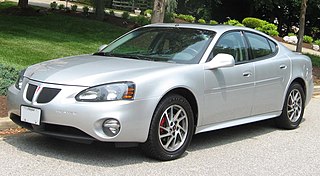
The Grand Prix is a line of automobiles produced by the Pontiac Division of General Motors from 1962 until 2002 as coupes and from 1989 through 2008 model years as four-door sedans.

The Oldsmobile 98 is the full-size flagship model of Oldsmobile that was produced from 1940 until 1942, and then from 1946 to 1996. The name – reflecting a "Series 90" fitted with an 8-cylinder engine – first appeared in 1941 and was used again after American consumer automobile production resumed post-World War II. It was, as it would remain, the division's top-of-the-line model, with lesser Oldsmobiles having lower numbers such as the A-body 66 and 68, and the B-body 76 and 78. The Series 60 was retired in 1949, the same year the Oldsmobile 78 was replaced by the 88. The Oldsmobile 76 was retired after 1950. This left the two remaining number-names to carry on into the 1990s as the bread and butter of the full-size Oldsmobile lineup until the Eighty Eight-based Regency replaced the 98 in 1997.
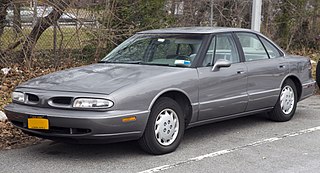
The Oldsmobile 88 is a full-size car that was sold and produced by Oldsmobile from 1949 until 1999. From 1950 until 1974, the 88 was the division's most profitable line, particularly the entry-level models such as the 88 and Dynamic 88. The 88 series was also an image leader for Oldsmobile, particularly in the early years (1949–51), when it was one of the best-performing automobiles, thanks to its relatively small size, light weight, and advanced overhead-valve high-compression V8 engine. This engine, originally designed for the larger C-bodied and more luxurious 98 series, also replaced the straight-8 on the smaller B-bodied 78. With the large, high performance V8, the Oldsmobile 88 is considered by some to be the first muscle car, although this title is disputed.

The Pontiac Catalina is a full-size automobile produced by Pontiac from 1950 to 1981. Initially, the name was a trim line on hardtop body styles, first appearing in the 1950 Chieftain Eight and DeLuxe Eight lines. In 1959, it became a separate model as the "entry-level" full-size Pontiac.

The Oldsmobile Toronado is a personal luxury car manufactured and marketed by the Oldsmobile division of General Motors from 1966 to 1992 over four generations. The Toronado was noted for its transaxle version of GM's Turbo-Hydramatic transmission, making it the first U.S.-produced front-wheel drive automobile since the demise of the Cord 810/812 in 1937.
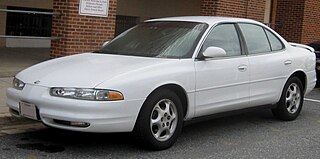
The Oldsmobile Intrigue is a mid-size sedan that was manufactured from 1997 through 2002 by Oldsmobile. The Intrigue's design cues were first seen in 1995 with the Oldsmobile Antares concept car, being unveiled in production form in January 1996 at the North American International Auto Show. The Intrigue was the first casualty in the three-year phase-out process of Oldsmobile; Olds' remaining models would last an additional year or two.

The Oldsmobile Cutlass Supreme is a mid-size car produced by Oldsmobile between 1966 and 1997. It was positioned as a premium offering at the top of the Cutlass range. It began as a trim package, developed its own roofline, and rose during the mid-1970s to become not only the most popular Oldsmobile but the highest selling model in its class.
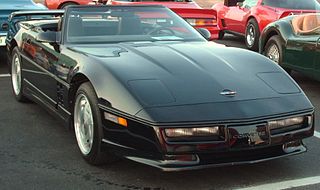
The Y platform, or Y body, designation has been used twice by the General Motors Corporation to describe a series of vehicles all built on the same basic body and sharing many parts and characteristics. The first was for a group of entry-level compacts including the conventional front-engine compacts built by GM divisions Buick, Oldsmobile and Pontiac from 1961 to 1963. The second, and current, incarnation is used for a high-end rear-wheel drive sports-car platform from the 1970s through the 2000s.

The Oldsmobile 4-4-2 is a muscle car produced by Oldsmobile between the 1964 and 1987 model years. Introduced as an option package for US-sold F-85 and Cutlass models, it became a model in its own right from 1968 to 1971, spawned the Hurst/Olds in 1968, then reverted to an option through the mid-1970s. The name was revived in the 1980s on the rear-wheel drive Cutlass Supreme and early 1990s as an option package for the new front-wheel drive Cutlass Calais.
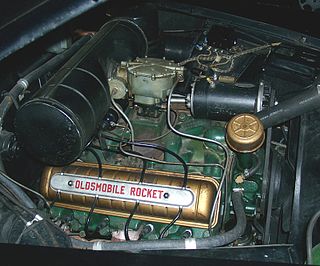
The Oldsmobile V8, also referred to as the Rocket, is a series of engines that was produced by Oldsmobile from 1949 until 1990. The Rocket, along with the 1949 Cadillac V8, were the first post-war OHV crossflow cylinder head V8 engines produced by General Motors. Like all other GM divisions, Olds continued building its own V8 engine family for decades, adopting the corporate Chevrolet 350 small-block and Cadillac Northstar engine only in the 1990s. All Oldsmobile V8s were assembled at plants in Lansing, Michigan while the engine block and cylinder heads were cast at Saginaw Metal Casting Operations.

The Gran Sport name has been used on several high-performance cars built by General Motors for its Buick brand since 1965. In the GM brands hierarchy, Buick was surpassed in luxury and comfort appointments only by Cadillac, which did not produce performance models. As a result, the Buick GS series were the most opulently equipped GM sport models of their era.

The Buick LeSabre is a full-size car made by the division Buick of General Motors from 1959 until 2005. Prior to 1959, this position had been retained by the full-size Buick Special model (1936–58). The "LeSabre", which is French for "the sabre", was Buick's mid-level full-size sedan above the Special but below the Electra during the 1960s then remained in its market position when the Electra was replaced with the Park Avenue. The LeSabre was available as a 2-door convertible, sedan or hardtop, a 4-door sedan or hardtop and station wagon throughout its production.

The Oldsmobile Vista Cruiser is a station wagon manufactured and marketed by Oldsmobile over three generations from 1964 to 1977.
The GM A platform was a rear wheel drive automobile platform designation used by General Motors from 1925 until 1959, and again from 1964 to 1981. In 1982, GM introduced a new front wheel drive A platform, and existing intermediate rear wheel drive products were redesignated as G-bodies.
The Oldsmobile Jetstar I is a sporty, high-performance full-sized car produced by Oldsmobile for the 1964 and 1965 model years. Based on the upscale Starfire model, the Olds 88's B-bodied Jetstar I lacked many of the Starfire's standard luxuries but shared its powerful engine, roofline and seating arrangement. Positioned to compete with Pontiac's successful full-sized Grand Prix, it was only offered as a two-door hardtop. The Jetstar I was made in Lansing, Michigan, Kansas City, Kansas, and Linden, New Jersey.

The second generation Pontiac Firebird was introduced in early 1970 by Pontiac for the 1970 model year.